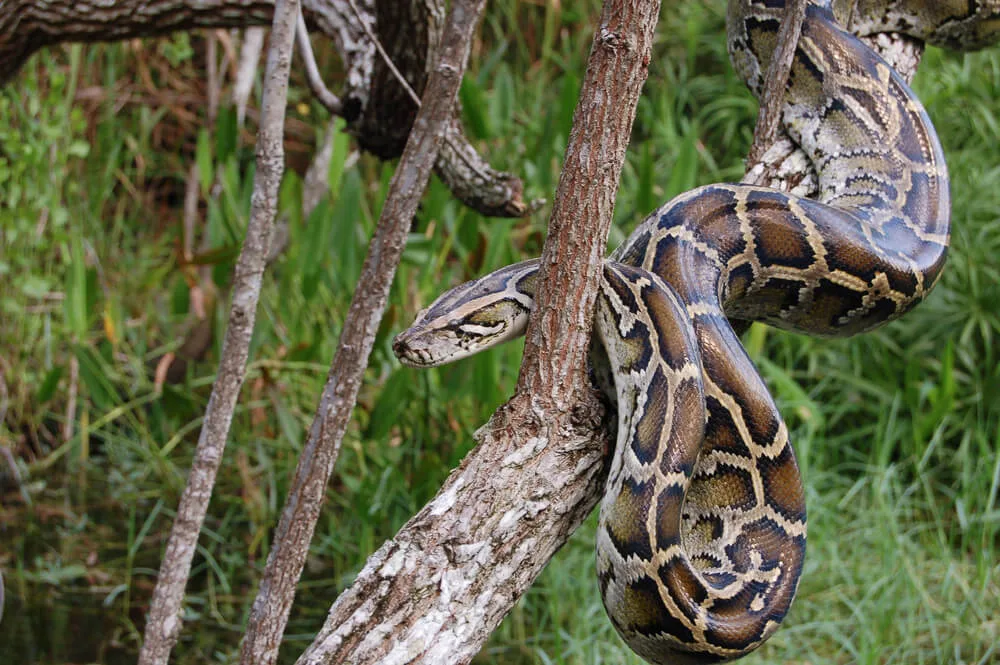
Image via Shutterstock/Heiko Kiera
Invasive Burmese pythons, which were first found in the Everglades, have already reached West Palm Beach and Fort Myers, and are now headed toward Central Florida.
At the 10th Annual Python Challenge, which took place in the Everglades in August, 1,050 participants from 35 states and Belgium removed 209 Burmese pythons from South Florida. The 10-day competition was created by the Florida Fish and Wildlife Conservation Commission (FWC) and partners to try to increase awareness about the invasive species and the threats the snakes pose to Florida’s ecology, as well as to try to eradicate Burmese pythons before they do more damage to Florida’s ecosystem.
That number was less than previous years, which may mean that the pythons are moving north looking for more food. The invasive species, which established itself as a population in the Everglades after pet pythons were released or escaped into the wild, has already decimated native species in the Everglades, including wading birds, marsh rabbits, and white-tailed deer. They have altered the food web and ecosystems across the Greater Everglades.
According to a comprehensive review of python science published in February of this year by the U.S. Geological Survey, pythons have been migrating throughout the state ever since an established breeding population was first documented in 2000.
They have now been found as far north as Lake Okeechobee. Isolated individuals may be found even further north, but it’s difficult to determine if they’re part of an established population of wild pythons or escaped or released captive animals.
RELATED: 7 Best Places to See Alligators in Florida
The review calls Burmese pythons “one of the most intractable invasive-species management issues across the globe.”
Since 2000, more than 19,000 wild Burmese pythons have been removed from the state of Florida and reported to FWC, however not much is known about how they live in the wild, how much the population has grown, or how they travel.
Experts theorize that the pythons travel through South Florida’s extensive network of canals and levees, according to the review. “One python transited continuously for 58.5 hours and traveled 2.43 kilometers in a single day,” the review said of a snake followed with radio tracking.
“We don’t really have a reliable estimate of how many are out there,” Melissa Miller of the Institute of Food and Agricultural Sciences at the University of Florida told The New York Times. “They’re kind of a cautionary tale to not to release pets, to make sure you report invasive species immediately.”
To report invasive species, call the Florida hotline: 888-IVE-GOT1.
Support Our Cause
Thank you for taking the time to read our work. Before you go, we hope you'll consider supporting our values-driven journalism, which has always strived to make clear what's really at stake for Floridians and our future.
Since day one, our goal here at Floricua has always been to empower people across the state with fact-based news and information. We believe that when people are armed with knowledge about what's happening in their local, state, and federal governments—including who is working on their behalf and who is actively trying to block efforts aimed at improving the daily lives of Florida families—they will be inspired to become civically engaged.


Stay safe, Puerto Rico: The governor issues a state of emergency due to heavy rains, flooding
The executive order also authorizes the activation of the National Guard to assist in relief efforts. The Guard will be tasked with providing...

Jennifer López and Bad Bunny steal the spotlight at Met Gala 2024
The artists were co-chairs of the event, alongside Zendaya and Chris Hemsworth. Rauw Alejandro also attended. Puerto Rican artists Jennifer López...

5 places in Florida to donate clothes, shoes, and more
Decluttering your home can provide such a satisfying feeling of accomplishment. After sorting through all of your belongings and determining what...

8 Orlando hotels that pack as much fun as the theme parks
With waterslides, family arcades, playgrounds for the kids, and spas for mom and dad, these Orlando hotels will make your vacation unforgettable!...



